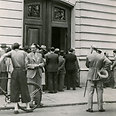
US Jews who helped refugees recognized
Exhibition opened at Museum of Jewish Heritage in Lower Manhattan includes images, rare documents, first-person accounts and interactive presentations about efforts of American Jews to bring refugees to US from Europe during Nazi era
The exhibition, "Against All Odds: American Jews and the Rescue of Europe's Refugees, 1933-41" will be on view for a year at the Museum of Jewish Heritage – A Living Memorial to the Holocaust, located on Battery Place.
Video courtesy of jn1.tv
The museum says the show is one of the first major exhibits about the subject, including images, rare documents, first-person accounts and interactive presentations.
Strict quotas on US visas made it difficult for refugees to get into the US during the Nazi era. A debate has raged for decades about whether the US Jewish community did enough to get Jews out, and whether the US government policies that impeded their immigration were the result of anti-Semitism among US officials, ignorance about the Jews' likely fate if they were not rescued, or, as some historians have argued, a matter of misguided wartime priorities.
But more than 200,000 Jews did leave Europe for the US during the Nazi era, and the exhibit tells the story of how some of them made it out thanks to the ingenuity and resources of the American Jewish community.
Stories include that of William B. Thalhimer Sr., a Richmond, Va., department store owner who turned an old tobacco plantation into a working farm in Hyde Park, Va., where 36 Jewish immigrants lived and worked. Also featured in the exhibit is Universal Pictures founder Carl Laemmle, who came to the US from Laupheim, Germany, and helped bring many individuals from the Laupheim area to the US The exhibit includes Laemmle's 1937 letter to Secretary of State Cordell Hull expressing sympathy for German Jews.

Carl Laemmle, founder of Universal Pictures who used his connections and resources to help bring Jews over from Europe after rise of Nazis, with his children, Rosabelle and Carl Jr. Laemmle (Photo: AP)
The show includes a 1941 letter from Albert Einstein to Eleanor Roosevelt as well, in which Einstein condemned the State Department's "wall of bureaucratic measures alleged to be necessary to protect America against subversive, dangerous elements." Einstein helped found an organization that later became the International Rescue Committee.
Some managed to save hundreds
Some of the refugee sponsors were well-connected individuals of means who were able to guarantee that those they brought to the US would be provided for and not become public burdens. They helped find jobs for them and set up charities to pay for their medical care and other needs.
But there are also stories of average folks who stepped in to help. In one case, a European Jewish composer named Erich Zeisl wrote a letter to someone he found in the New York phone book with a similar name. They were not related, but the New Yorker, Morris Zeisel, a plumber, wrote back immediately and got the paperwork necessary to bring the composer and his wife over.
"We hope that 'Against All Odds' dispels misconceptions about American Jewish passivity during the Nazi period," Anita Kassof, the museum's deputy director, said in a press release. "It's true that American immigration law restricted the number of people admitted to the US But within those limits, it was sometimes possible for dedicated and persistent people to bring refugees to safety."
Some of the rescuers managed to save hundreds of people, but "each started out by bringing an individual or a single family to America," she added.
Not all of those who sought to get Jews out of Europe succeeded. "Against the Odds" also describes some of the failed efforts and those left behind.
The show also includes artifacts like photos, diaries, seed packets from the Virginia farm, and a beaded bracelet that refugee Lotte Henlein made as a Girl Scout in North Dakota. Henlein's uncle, Herman Stern, lived in North Dakota and encouraged all young immigrants to join the Scouts as a way of learning American values.










